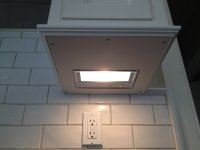I'm reading Danny Proulx's book on 32mm cabinetmaking and had expected some mention of allowing for under cabinet lighting, but there wasn't any. In the kitchen where I work which has frameless cabinets I noticed that the wall cabinets have an extra narrow front piece on the bottom which could hide under cabinet lighting and the doors are sized to cover that front panel so when they are closed all you see are the doors. From this I would assume that the extra piece is exactly 32mm wide (I haven't brought my rule in to measure them) so the doors that cover them are still a multiple of 32mm. Is this how it's typically done? Does this mean that cabinets built this way have a little less interior height than normal, or are the cabinets extended from the standard by the extra amount (the extra piece on the bottom isn't really considered part of the cabinet height)?
How to allow for under cabinet lighting with the 32mm system?
- Thread starter sprior
- Start date


